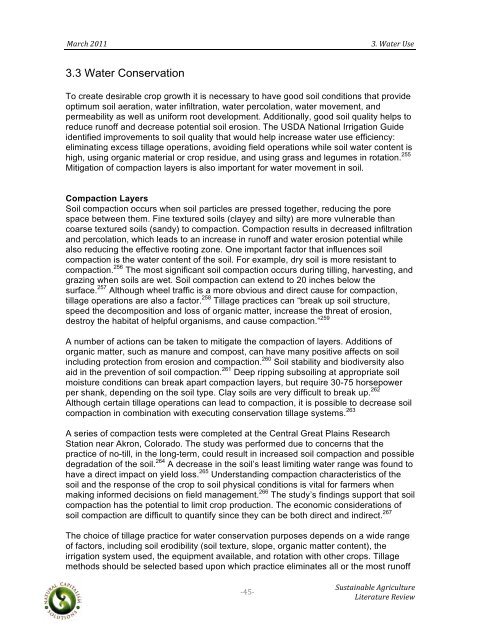Sustainable Agriculture Literature Review - Boulder County
Sustainable Agriculture Literature Review - Boulder County
Sustainable Agriculture Literature Review - Boulder County
Create successful ePaper yourself
Turn your PDF publications into a flip-book with our unique Google optimized e-Paper software.
! !!<br />
"#$%&!'())!! !!!!!!!!!!!!!!!!!!!!!!!!!!!!!!!!!!!!!!!!!!!!!!!!!!!!!!!!!!!!!!!!!!!!!!!!!?=!@#-2$!A,2!<br />
3.3 Water Conservation<br />
To create desirable crop growth it is necessary to have good soil conditions that provide<br />
optimum soil aeration, water infiltration, water percolation, water movement, and<br />
permeability as well as uniform root development. Additionally, good soil quality helps to<br />
reduce runoff and decrease potential soil erosion. The USDA National Irrigation Guide<br />
identified improvements to soil quality that would help increase water use efficiency:<br />
eliminating excess tillage operations, avoiding field operations while soil water content is<br />
high, using organic material or crop residue, and using grass and legumes in rotation. 255<br />
Mitigation of compaction layers is also important for water movement in soil.<br />
Compaction Layers<br />
Soil compaction occurs when soil particles are pressed together, reducing the pore<br />
space between them. Fine textured soils (clayey and silty) are more vulnerable than<br />
coarse textured soils (sandy) to compaction. Compaction results in decreased infiltration<br />
and percolation, which leads to an increase in runoff and water erosion potential while<br />
also reducing the effective rooting zone. One important factor that influences soil<br />
compaction is the water content of the soil. For example, dry soil is more resistant to<br />
compaction. 256 The most significant soil compaction occurs during tilling, harvesting, and<br />
grazing when soils are wet. Soil compaction can extend to 20 inches below the<br />
surface. 257 Although wheel traffic is a more obvious and direct cause for compaction,<br />
tillage operations are also a factor. 258 Tillage practices can “break up soil structure,<br />
speed the decomposition and loss of organic matter, increase the threat of erosion,<br />
destroy the habitat of helpful organisms, and cause compaction.” 259<br />
A number of actions can be taken to mitigate the compaction of layers. Additions of<br />
organic matter, such as manure and compost, can have many positive affects on soil<br />
including protection from erosion and compaction. 260 Soil stability and biodiversity also<br />
aid in the prevention of soil compaction. 261 Deep ripping subsoiling at appropriate soil<br />
moisture conditions can break apart compaction layers, but require 30-75 horsepower<br />
per shank, depending on the soil type. Clay soils are very difficult to break up. 262<br />
Although certain tillage operations can lead to compaction, it is possible to decrease soil<br />
compaction in combination with executing conservation tillage systems. 263<br />
A series of compaction tests were completed at the Central Great Plains Research<br />
Station near Akron, Colorado. The study was performed due to concerns that the<br />
practice of no-till, in the long-term, could result in increased soil compaction and possible<br />
degradation of the soil. 264 A decrease in the soil’s least limiting water range was found to<br />
have a direct impact on yield loss. 265 Understanding compaction characteristics of the<br />
soil and the response of the crop to soil physical conditions is vital for farmers when<br />
making informed decisions on field management. 266 The study’s findings support that soil<br />
compaction has the potential to limit crop production. The economic considerations of<br />
soil compaction are difficult to quantify since they can be both direct and indirect. 267<br />
The choice of tillage practice for water conservation purposes depends on a wide range<br />
of factors, including soil erodibility (soil texture, slope, organic matter content), the<br />
irrigation system used, the equipment available, and rotation with other crops. Tillage<br />
methods should be selected based upon which practice eliminates all or the most runoff<br />
!<br />
"%&"<br />
!*+,-#./#012!34$.%+1-+$2!<br />
5.-2$#-+$2!627.28!
















